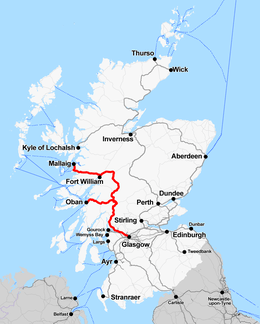West Highland Line
The West Highland Line (Scottish Gaelic: Rathad Iarainn nan Eilean - "Iron Road to the Isles") is a railway line linking the ports of Mallaig and Oban in the Scottish Highlands to Glasgow in Central Scotland. The line was voted the top rail journey in the world by readers of independent travel magazine Wanderlust in 2009, ahead of the notable Trans-Siberian line in Russia and the Cuzco to Machu Picchu line in Peru.[2][3][4] The ScotRail website has since reported that the line has been voted the most scenic railway line in the world for the second year running.
| West Highland Line | |||
|---|---|---|---|
 | |||
| Overview | |||
| Type | Rural Rail[1] | ||
| System | National Rail | ||
| Status | Operational | ||
| Locale | Glasgow Argyll and Bute Highland Scotland | ||
| Termini | Glasgow Queen Street Mallaig Oban | ||
| Stations | 33 | ||
| Operation | |||
| Owner | Network Rail | ||
| Operator(s) | Caledonian Sleeper Abellio ScotRail West Coast Railways | ||
| Rolling stock | Class 156 "Super Sprinter" Caledonian Sleeper stock | ||
| Technical | |||
| Line length | Glasgow Queen Street to Crianlarich: 59 miles 22 chains (95.4 km) Crianlarich to Oban: 41 miles 73 chains (67.5 km) Crianlarich to Fort William: 63 miles 14 chains (101.7 km) Fort William to Mallaig: 41 miles 28 chains (66.5 km) *Total (including reversing at Fort William): 205 miles 57 chains (331.1 km) | ||
| Number of tracks | One | ||
| Track gauge | 1,435 mm (4 ft 8 1⁄2 in) | ||
| Operating speed | 70 mph (110 km/h) maximum[1] | ||
| |||
The West Highland Line is one of two railway lines which access the remote and mountainous west coast of Scotland, the other being the Kyle of Lochalsh Line which connects Inverness with Kyle of Lochalsh. The line is the westernmost railway line in Great Britain.
At least in part, the West Highland Line is the same railway line as that referred to as the West Highland Railway.
History
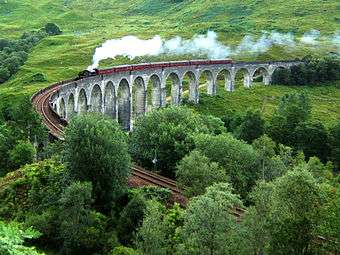
The route was built in several sections:-
- Glasgow Queen Street to Cowlairs Junction - Edinburgh and Glasgow Railway
- Cowlairs Junction to Bowling - Glasgow, Dumbarton and Helensburgh Railway (later absorbed into the Edinburgh and Glasgow Railway)
- Bowling to Dumbarton Central - Lanarkshire and Dunbartonshire Railway, operated by the Caledonian Railway
- Dumbarton Central to Dalreoch - Caledonian and Dunbartonshire Junction Railway
- Dalreoch to Craigendoran - Glasgow, Dumbarton and Helensburgh Railway
- Craigendoran to Fort William (opened 11 August 1894)[5][6][7] - West Highland Railway sponsored by the North British Railway
- Crianlarich to Oban[8] - Callander and Oban Railway, operated by the Caledonian Railway.
There is an additional section from Fort William (or a junction near Fort William) to Mallaig, built as the Mallaig Extension Railway.[9] The West Highland Railway approved the construction of the line at their annual meeting in January 1895.[10]
The line faced potential closure as part of the Beeching cuts in 1963[11] and again in 1995 due to reduced revenues.[12][13]
Route description

Shortly after leaving Glasgow Queen Street station, and beyond Queen Street Tunnel, the line diverges from the main trunk route to Edinburgh and Perth at Cowlairs and follows a northwesterly course through the suburbs of Maryhill and Kelvindale. Between Westerton and Dumbarton, the route is shared with the North Clyde Line to Helensburgh before branching northward at Craigendoran Junction towards Garelochhead, the section where the West Highland Line itself is generally accepted to begin. It gives high-level views of the Gareloch and Loch Long before emerging alongside the northwesterly shores of Loch Lomond, then climbs Glen Falloch to Crianlarich.
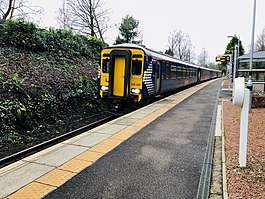
The branch to Oban diverges at Crianlarich, an important Highland junction of both road and rail, and runs through Glen Lochy to Dalmally and through the Pass of Brander to reach salt water at Taynuilt and Connel Ferry before a final climb over a hill to Oban. Both the Maillaig and Oban branches of the line pass through the village of Tyndrum about 5km from Crianlarich, making it both the smallest and most-northerly settlement in the UK to be served by more than one railway station.
After Bridge of Orchy, the line climbs onto Rannoch Moor, past the former crossing point at Gorton Crossing to Rannoch station. In winter, the moor is often covered with snow,[note 1] and deer may be seen running from the approaching train. The station at Corrour on the moor is one of the most remote stations in Britain and is not accessible by any public road. This is the summit of the line at 410 m (1347 ft) above sea level. Carrying on northwards, the line descends above the shores of Loch Treig and through the narrow Monessie Gorge. The final stop before Fort William is Spean Bridge. The section between Fort William and Mallaig passes over the Glenfinnan Viaduct, through Arisaig with its views of the Small Isles of Rùm, Eigg, Muck and Canna, and the white sands of Morar before coming to Mallaig itself.
With the exception of the route between Glasgow Queen Street and Helensburgh Upper, and the short section between Fort William Junction and Fort William station, the railway is signalled using the Radio Electronic Token Block, controlled from the signal box at Banavie station.
Services
Passenger services on the line are operated by Abellio ScotRail and Caledonian Sleeper: six daily return services between Glasgow Queen Street and Oban, three daily return services between Glasgow Queen Street and Mallaig, and one nightly (except Saturdays) Caledonian Sleeper service between London Euston and Fort William.
During the summer season from May until October a steam locomotive-hauled daily return service between Fort William and Mallaig known as The Jacobite is operated by West Coast Railways. There is one train a day in May, September and October, and two trains per day from June until the end of August.
Onward ferry connections operated by Caledonian MacBrayne are available from Mallaig to the Isle of Skye, to the small isles of Rùm, Eigg, Muck, and Canna, to South Uist, and to Inverie on the Knoydart peninsula. From Oban ferries sail to the islands of Lismore, Colonsay, Coll, Tiree, Mull and Barra.
Route timings
Since improvements to Scottish trunk roads in the 1980s, a train journey can take significantly longer than the equivalent road journey. There are several reasons for this. The line is entirely single track once it leaves the North Clyde suburban network at Craigendoran and trains must wait at stations with crossing loops for opposite direction trains to pass. Even when no crossing is timetabled, each train must pause at the various token exchange points whilst the driver contacts the main signalling centre at Banavie to swap tokens electronically and obtain permission to proceed. Up to 15 minutes have to be allocated for trains to divide or combine at the junction station at Crianlarich, whilst trains heading to/from Mallaig also have to reverse at Fort William & traverse the Banavie swing bridge at low speed. A further issue is finding suitable timetable paths for Oban & Mallaig trains on the busy North Clyde line, which carries an intensive local stopping service. As West Highland trains only stop at Dumbarton Central and Dalmuir on this stretch, it is not uncommon for them be delayed by a preceding local train and so recovery time has to be included in their schedules to reduce the possibility of a late arrival in Glasgow.
Over much of the Rannoch Moor section the speed limit is 60 mph for the Sprinter and 70 mph on the approach to Rannoch station. The Caledonian Sleeper travels at 40 mph maximum, slowing down for a number of bridges on the route due to the heavy weight of the Class 67 locomotive which hauled the train until the end of the old franchise in April 2015. New sleeper operator Serco has replaced these with refurbished Class 73/9 electro-diesels since it took over, which have a lighter axle load; it isn't yet clear if the new locos will be cleared to run at higher speeds now they are in service.[17]
Rolling stock
Past, present and future rolling stock on the line
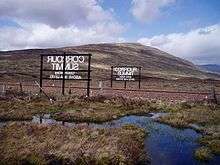
| Past Rolling Stock (From 1980) | |||||||||
|---|---|---|---|---|---|---|---|---|---|
| Class | Image | Operator | Route | Maximum Speed | Builder/
Built |
In Service on the line | Leased From | Other Notes | |
| mph | km/h | ||||||||
| 37 | 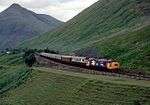 |
British Rail (Until 1983) BR ScotRail (From 1983) |
Glasgow Queen Street to Oban/Mallaig (Until 1989) London Euston to Fort William (Takes over from electric loco at Edinburgh) Freight |
80 | 130 | English Electric 1960-1965 |
1981-1985 | N/A | Class 37/0 |
| BR ScotRail | Glasgow Queen Street to Oban/Mallaig (Until 1989) London Euston to Fort William (Takes over from electric loco at Edinburgh) Freight |
90 | 145 | 1985-2006 | Class 37/4 | ||||
| 67 |  |
First ScotRail (Until 2015) Caledonian Sleeper (Until 2018) |
London Euston to Fort William (Took over from electric loco at Edinburgh) |
125 | 201 | Alstom 1999-2000 | 2006-2016 | DB Cargo UK | |
| Mark 1 Passenger Coach |  |
British Rail (Until 1983) BR ScotRail (From 1983) The Royal Scotsman (1985 - 1989) |
Glasgow Queen Street to Oban or Mallaig | 100 | 160 | 1951-1963 | 1961-1989 | N/A | |
| Mark 2 Passenger Coach | Caledonian Sleeper | London Euston to Fort William | 100 | 160 | BREL 1963-1975 | 1964-December 2018 | Replaced in 2019 by new British Rail Mark 5s. | ||
| West Coast Railways | Special Passenger Workings | ||||||||
| Mark 3 Sleeper Coach | 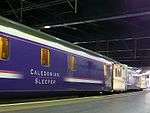 |
Caledonian Sleeper | London Euston to Fort William | 125 | 201 | BREL 1979-1980 | 1980-December 2018 | Replaced in 2019 by new British Rail Mark 5s | |
| Belmond Limited | Special Passenger Workings (Royal Scotsman) |
||||||||
| Current Fleet | |||||||||
| 73/9 | Caledonian Sleeper | London Euston to Fort William (Takes over from electric loco at Edinburgh) |
90 | 145 | British Railways Eastleigh Works 1962 English Electric 1965-1967 Rebuilt 2014-2016 |
2016- | GB Railfreight | Replaced Class 67 when their lease from DB Cargo UK Expired Class 73/9. | |
| 66 | .jpg) |
Freight | 75 | 121 | Electro-Motive Diesel 1998-2015 | 2000- | N/A | Class 66/7 | |
| Belmond Limited | Special Passenger Workings
(Royal Scotsman) |
GB Railfreight | |||||||
| 37 | .jpg) |
West Coast Railways | Special Passenger Workings
(Royal Scotsman) |
90 | 145 | English Electric 1960-1965 | 1985- | Direct Rail Services | Class 37/5 |
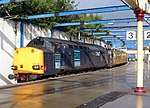 |
Direct Rail Services | Freight/Special Passenger Workings | N/A | Class 37/6 | |||||
| 56 | Colas Rail Freight | Freight | 80 | 129 | Electroputere | 2017 - | N/A | Oil traffic to Fort William currently suspended | |
| LMS Stanier Class 5 4-6-0 |  |
West Coast Railways | Mallaig to Fort William | 40 | 64 | - | - | The Jacobite | |
| Peppercorn Class K1 | 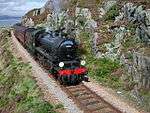 |
40 | 64 | - | - | ||||
| Mark 1 Passenger coach | 100 | 160 | Cravens 1951-1963 | ||||||
| Mark 5 Passenger Coach | 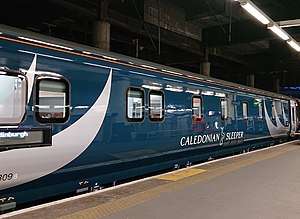 |
Caledonian Sleeper | London Euston to Fort William | 100 | 161 | CAF 2016-2018 | Oct 2019- | Caledonian Sleeper Rail Leasing | Replaced the Mark 2s |
| Mark 5 Sleeper Coach | Replaced the Mark 3s | ||||||||
| Pullman Mark 3 coach |  |
Belmond Limited | Special Passenger Workings (Royal Scotsman) |
125 | 201 | BREL 1979-1980 | 1990- | ||
| Future Rolling Stock | |||||||||
| 153 | Abellio ScotRail | Glasgow Queen Street to Oban/Mallaig | 75 | 121 | Leyland Bus 1987-1988 as Class 155s[18] Converted to Class 153 by Hunslet-Barclay 1991-1992[19] |
2019 (Scheduled) | N/A | These single car units are to be completely adapted to accommodate bikes, skis and other outdoor equipment. They will be attached to the Class 156s either as centre cars, or as extra coaches at either end.[20] | |
In early 2018 it was widely reported that Class 158s would be used from Q3-Q4 2018 to replace the Class 156s. However, following investigation it was discovered that the line does not have sufficient gauge clearance for the class. As of August 2018 studies were still ongoing.[21]
Some notable railway-related features
- The Horse Shoe Curve, between Upper Tyndrum and Bridge of Orchy
- The Cruach Rock snowshed, between Rannoch and Corrour
- Glenfinnan viaduct, between Locheilside and Glenfinnan
- The Pass of Brander stone signals, between Dalmally and Taynuilt
- Arisaig is the furthest west railway station in Great Britain.
The two branches of the line are described in detail by John Thomas in his two books (see Sources).
The route in detail
| West Highland Line | |||||||||||||||||||||||||||||||||||||||||||||||||||||||||||||||||||||||||||||||||||||||||||||||||||||||||||||||||||||||||||||||||||||||||||||||||||||||||||||||||||||||||||||||||||||||||||||||||||||||||||||||||||||||||||||||
|---|---|---|---|---|---|---|---|---|---|---|---|---|---|---|---|---|---|---|---|---|---|---|---|---|---|---|---|---|---|---|---|---|---|---|---|---|---|---|---|---|---|---|---|---|---|---|---|---|---|---|---|---|---|---|---|---|---|---|---|---|---|---|---|---|---|---|---|---|---|---|---|---|---|---|---|---|---|---|---|---|---|---|---|---|---|---|---|---|---|---|---|---|---|---|---|---|---|---|---|---|---|---|---|---|---|---|---|---|---|---|---|---|---|---|---|---|---|---|---|---|---|---|---|---|---|---|---|---|---|---|---|---|---|---|---|---|---|---|---|---|---|---|---|---|---|---|---|---|---|---|---|---|---|---|---|---|---|---|---|---|---|---|---|---|---|---|---|---|---|---|---|---|---|---|---|---|---|---|---|---|---|---|---|---|---|---|---|---|---|---|---|---|---|---|---|---|---|---|---|---|---|---|---|---|---|---|---|---|---|---|---|---|---|---|---|---|---|---|---|---|---|---|---|
| |||||||||||||||||||||||||||||||||||||||||||||||||||||||||||||||||||||||||||||||||||||||||||||||||||||||||||||||||||||||||||||||||||||||||||||||||||||||||||||||||||||||||||||||||||||||||||||||||||||||||||||||||||||||||||||||
Places served along the route from Glasgow Queen Street are listed below. Sleeper services to Fort William start, however, at London Euston, calling at Edinburgh Waverley and Queen Street Low Level (to pick up or set down depending on direction).
West Highland Line in film
- Glenfinnan Viaduct, on the line between Fort William and Mallaig, is a filming location for the Hogwarts Express in the Harry Potter series of films.[22]
- Eddie McConnell's poetic documentary A Line for All Seasons (1970) showcases the line and its history set against the scenery of the western highlands as it changes through the seasons.[23]
- Corrour station features in Trainspotting (1996), directed by Danny Boyle.
Museum
There is a museum dedicated to the history of the West Highland Line situated at Glenfinnan Station.
Gallery
 A freight train heading south on the West Highland Line
A freight train heading south on the West Highland Line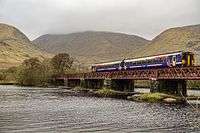 A Scotrail service crosses Loch Awe in 2017
A Scotrail service crosses Loch Awe in 2017 Bridge of Orchy Station in 1961
Bridge of Orchy Station in 1961 Railway Bridge near Inverlochy Castle
Railway Bridge near Inverlochy Castle Approaching the Glenfinnan Viaduct
Approaching the Glenfinnan Viaduct
Notes
References
Footnotes
- Network Rail. "Delivering for You - Route Plans 2007" (PDF). Archived from the original (PDF) on 1 October 2012. Retrieved 9 July 2011.
- "Highland train line best in world". BBC News. 6 February 2009. Retrieved 6 February 2009.
- "Wanderlust Travel Awards announced". Wanderlust. 5 February 2009. Archived from the original on 1 August 2010. Retrieved 6 February 2009.
- Donnelly, Brian; Taylor, Marianne (6 February 2009). "Highland line voted world's most scenic train journey". The Herald. Archived from the original on 26 September 2019. Retrieved 6 February 2009.
- "Opening of the West Highland Railway". The Observer. Lodnon. 12 August 1894. p. 7 – via Newspapers.com.

- "A New Highland Railway". The Bristol Mercury and Daily Post, Western Countries and South Wales Advertiser. Bristol, England. 13 August 1894. p. 5 – via Newspapers.com.

- Fine, Mary Jane (26 January 2003). "Fling: Highland train". The Record. Hackensack, New Jersey. p. 145 – via Newspapers.com.

- "Railway Enterprise in the North - Railway extension in the West Highlands". The Courier and Argus. Dundee, Scotland. 15 August 1895. p. 6 – via Newspapers.com.

- "The West Highland Railway (Mallaig Extension) Bill". Glasgow Herald. 28 April 1894. p. 3 – via Newspapers.com.

- "Railway Meetings - West Highland Railway". Glasgow Herald. 18 January 1895. p. 10 – via Newspapers.com.

- Ascherson, Neal (13 January 1963). "Lifeline in Jeopardy". The Observer. London. p. 21 – via Newspapers.com.

- Johnson, Maureen (14 May 1995). "Scottish rail ride faces closure". Johnson City Press. Johnson City, Tennessee. Associated Press. p. 44 – via Newspapers.com.

- O'Kelly, Lisa (14 May 1995). "Deerstalker sees light at end of the tunnel". The Observer. London. p. 7 – via Newspapers.com.

- "The Weather - The snow blocks in Scotland - A passage cut through the West Highland Line". Sheffield and Rotherham Independent. Sheffield, England. 10 January 1895. p. 5 – via Newspapers.com.

- "(untitled)". Glasgow Herald. 8 February 1895. p. 6 – via Newspapers.com.

- "The storm disasters". Aberdeen Journal, and General Advertiser for the North of Scotland. 9 January 1895. p. 6 – via Newspapers.com.

- "Class 73s for sleeper train". Friends of the West Highland Line. Archived from the original on 27 August 2016. Retrieved 26 August 2016.
- Dave Coxon. "Class 155 Super Sprinter DMU". Archived from the original on 3 November 2014. Retrieved 2 March 2014.
- "Class 153 - Arriva Trains Wales, Great Western Railway, East Midlands Trains, Arriva Rail North". Angel Trains. Retrieved 24 January 2018.
- Devereux, Nigel (31 December 2018). "Options Revealed for ScotRail Class 153 Conversion". The Railway Magazine.
- "2018 AGM Report". Friends of the West Highland Lines. Archived from the original on 23 August 2018. Retrieved 23 August 2018.
- Hawkes, Will (16 February 2020). "Slow train's rewards just outside window". The Philadelphia Inquirer. Washington Post News Service. p. H14 – via Newspapers.com.

- "Full record for 'LINE FOR ALL SEASONS, a'". Scottish Screen Archive. Retrieved 6 February 2009.
Sources
- Thomas, John (1965). The West Highland Railway. Newton Abbot: David and Charles (Publishers) Ltd. ISBN 0-7153-7281-5.
- Thomas, John (1966). The Callander and Oban Railway (1st ed.). Newton Abbot, Devon: David & Charles. OCLC 2316816.
- Thomas, John; Farrington, J.H. (1990). The Callander and Oban Railway (2nd ed.). Newton Abbot, Devon: David St John Thomas. OCLC 60059451.
- Thomas, John (2000). The Callander and Oban Railway (3rd ed.). Newton Abbot, Devon: David St John Thomas. ISBN 0-9465-3761-5. OCLC 228266316.
Further reading
- McGregor, John (2013). Great Railway Journeys Through Time: West Highland Line. Amberley Publishing. ISBN 9781445613369. OCLC 839316369.
- Kelly, Peter (September 1983). "Pearls beyond price". Rail Enthusiast. EMAP National Publications. pp. 23–33. ISSN 0262-561X. OCLC 49957965.
- Bellass, Eddie (June 1984). "Oban line". Rail Enthusiast. EMAP National Publications. pp. 35–37, 39. ISSN 0262-561X. OCLC 49957965.
External links
| Wikimedia Commons has media related to West Highland Line. |
| Wikivoyage has a travel guide for West Highland Line. |
